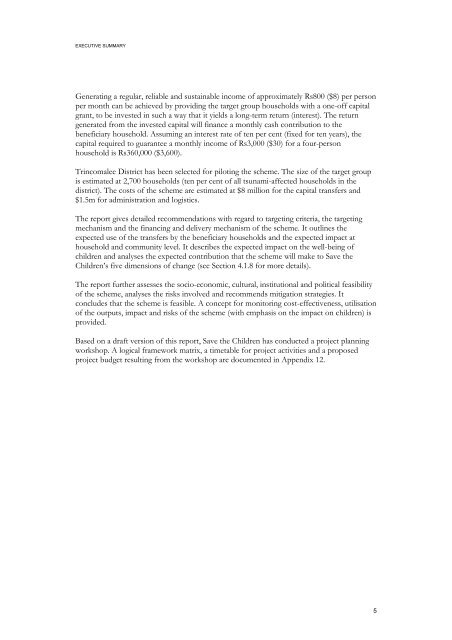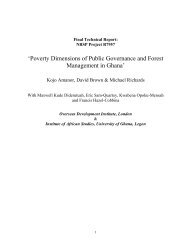Feasibility study on a capital-based income generation scheme for ...
Feasibility study on a capital-based income generation scheme for ...
Feasibility study on a capital-based income generation scheme for ...
You also want an ePaper? Increase the reach of your titles
YUMPU automatically turns print PDFs into web optimized ePapers that Google loves.
EXECUTIVE SUMMARY<br />
Generating a regular, reliable and sustainable <strong>income</strong> of approximately Rs800 ($8) per pers<strong>on</strong><br />
per m<strong>on</strong>th can be achieved by providing the target group households with a <strong>on</strong>e-off <strong>capital</strong><br />
grant, to be invested in such a way that it yields a l<strong>on</strong>g-term return (interest). The return<br />
generated from the invested <strong>capital</strong> will finance a m<strong>on</strong>thly cash c<strong>on</strong>tributi<strong>on</strong> to the<br />
beneficiary household. Assuming an interest rate of ten per cent (fixed <strong>for</strong> ten years), the<br />
<strong>capital</strong> required to guarantee a m<strong>on</strong>thly <strong>income</strong> of Rs3,000 ($30) <strong>for</strong> a four-pers<strong>on</strong><br />
household is Rs360,000 ($3,600).<br />
Trincomalee District has been selected <strong>for</strong> piloting the <strong>scheme</strong>. The size of the target group<br />
is estimated at 2,700 households (ten per cent of all tsunami-affected households in the<br />
district). The costs of the <strong>scheme</strong> are estimated at $8 milli<strong>on</strong> <strong>for</strong> the <strong>capital</strong> transfers and<br />
$1.5m <strong>for</strong> administrati<strong>on</strong> and logistics.<br />
The report gives detailed recommendati<strong>on</strong>s with regard to targeting criteria, the targeting<br />
mechanism and the financing and delivery mechanism of the <strong>scheme</strong>. It outlines the<br />
expected use of the transfers by the beneficiary households and the expected impact at<br />
household and community level. It describes the expected impact <strong>on</strong> the well-being of<br />
children and analyses the expected c<strong>on</strong>tributi<strong>on</strong> that the <strong>scheme</strong> will make to Save the<br />
Children’s five dimensi<strong>on</strong>s of change (see Secti<strong>on</strong> 4.1.8 <strong>for</strong> more details).<br />
The report further assesses the socio-ec<strong>on</strong>omic, cultural, instituti<strong>on</strong>al and political feasibility<br />
of the <strong>scheme</strong>, analyses the risks involved and recommends mitigati<strong>on</strong> strategies. It<br />
c<strong>on</strong>cludes that the <strong>scheme</strong> is feasible. A c<strong>on</strong>cept <strong>for</strong> m<strong>on</strong>itoring cost-effectiveness, utilisati<strong>on</strong><br />
of the outputs, impact and risks of the <strong>scheme</strong> (with emphasis <strong>on</strong> the impact <strong>on</strong> children) is<br />
provided.<br />
Based <strong>on</strong> a draft versi<strong>on</strong> of this report, Save the Children has c<strong>on</strong>ducted a project planning<br />
workshop. A logical framework matrix, a timetable <strong>for</strong> project activities and a proposed<br />
project budget resulting from the workshop are documented in Appendix 12.<br />
5
















